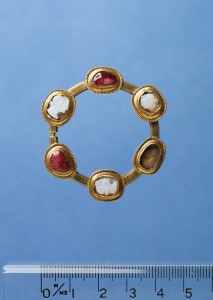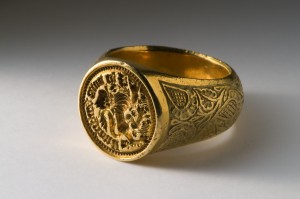
JewelleryBoth men and women wore jewellery such as rings, brooches and chains. The most select of these were made of gold, adorned with beautiful beads or precious stones.
A Welsh term for a type of jewellery in this period was cae. This word can refer to any kind of object, whether a hair ornament or a decoration on clothing, or a belt. There are suggestions in the poetry that a cae was usually a type of circular brooch. Guto’r Glyn, for example, refers to a cae arian in his poem to request an Irish mantle from Elen daughter of Robert Puleston of Llannerch, though in fact he is emphasizing that he wants a mantle rather than a silver brooch or a cae arian (poem 53.33). The giving of a cae or a brooch as a love token was a familiar tradition between lovers in this period.
Gold finger-rings were also popular as gifts. Guto refers to three famous gifts that the poets had received from their patrons: Ifor Hael gave Dafydd ap Gwilym a pair of gloves; Maud daughter of Sir William Clement gave Iolo Goch a finger-ring and Catrin daughter of Maredudd of Abertanad gave Guto’r Glyn a purse (for the latter, see Purses). Unfortunately, no poem by Iolo Goch concerning this finger-ring has survived. Several gold rings have been discovered dating from this period. The most important, perhaps, is the one from Raglan castle. It is a ring inscribed with the letters 'W' and 'A'. It is quite possible that these letters represent the initials of Sir William Herbert I and his wife Ann Herbert of Raglan. Individuals of lower status wore less ornate gold rings, and many have been found that date from this period.[1] <<<Purses |
Unless otherwise noted, copyright on the content of this website belongs to the University of Wales







